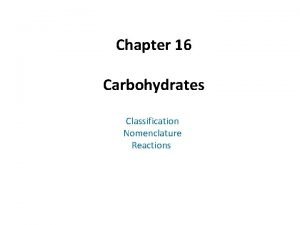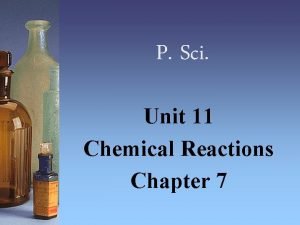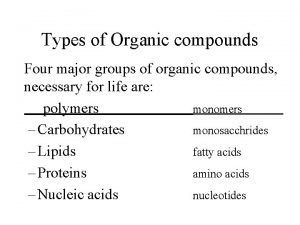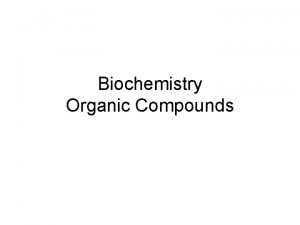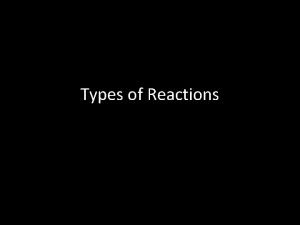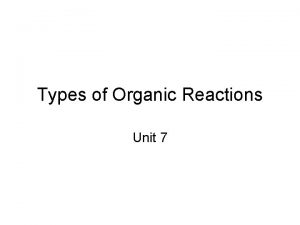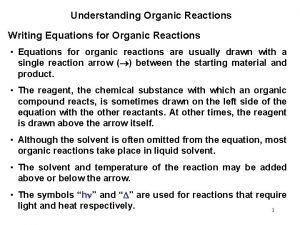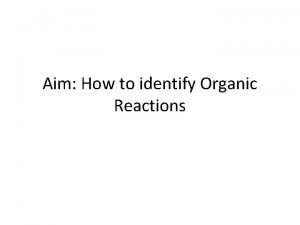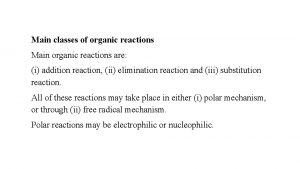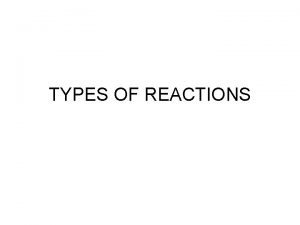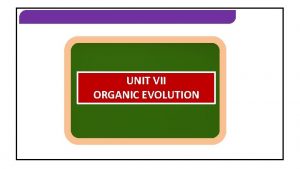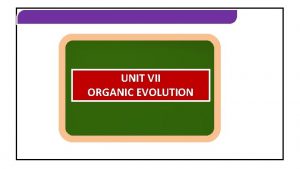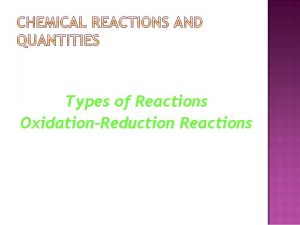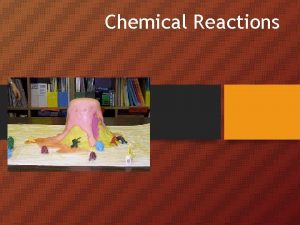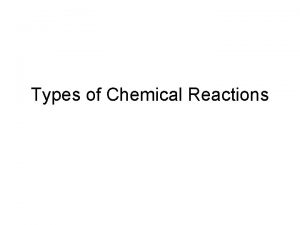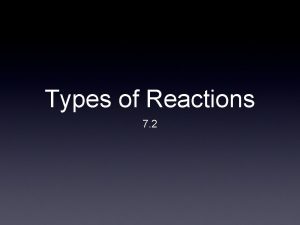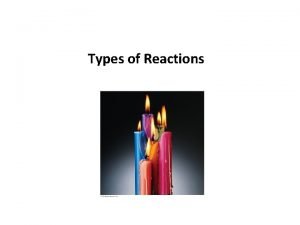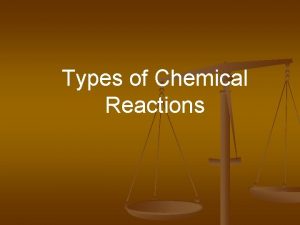Unit Processes Lecture1 Types of Organic Reactions Types





















- Slides: 21

Unit Processes Lecture-1 Types of Organic Reactions

Types of Organic Reactions • Addition Reaction • Elimination Reaction • Substitution Reaction • Condensation Reaction • Esterification Reaction • Hydrolysis Reaction • Oxidation Reaction • Reduction Reaction

1. Addition Reaction • Alkenes and alkynes characteristically undergo addition reactions in which atoms are added to a double or triple bond. • Above reaction is the general form of addition reaction.

These are some examples of addition reaction in alkenes.

• The following equation is an example of an addition reaction in which chlorine gas reacts with but-2 -ene. • In this addition reaction, the double bond between the carbon atoms is replaced by single bonds with the chlorine atoms.

Addition of Bromine • Chemists use the addition reaction of bromine with an alkene as a colour test for the presence of double or triple bond. • The loss of brownish colour indicates that the compound contains multiple bonds.

2. Elimination Reaction • In an elimination reaction, atoms are removed from an organic molecule and a double bond forms between the two carbon atoms. • This reaction is the general form of an elimination reaction.

• The equation below illustrates how alcohols can undergo elimination reaction to give alkenes. • This reaction takes place at high temperature and in presence of strong acid.

• Haloalkanes can undergo elimination reactions to produce alkenes when they are heated in the presence of a strong base, such as sodium ethoxide, Na. OCH 2 CH 3.

3. Substitution Reaction • In a substitution reaction, a hydrogen atom or a functional group is replaced by a different functional group. • This is the general form of a substitution reaction. • Commonly, alcohols and haloalkanes undergo substitution reaction.

• The halogen atom is substituted for the hydroxyl group of the alcohol, as shown in the equation below. • A haloalkane is produced. • A haloalkane can undergo a substitution reaction with a hydroxide ion to produce an alcohol, as shown below.

• Like alkanes, most aromatic hydrocarbons are fairly stable. They will undergo substitution reactions with chlorine and bromine but only in the presence of a catalyst.

4. Condensation Reaction • A condensation reaction is a reaction in which two molecules combine and form one larger molecule and a very small molecule, usually water. • In this example of a condensation reaction, the carboxylic acid and the amine combine to form a larger molecule, the amide, and a smaller molecule, the water.

5. Esterification Reaction • An esterification reaction is a special type of condensation reaction in which a carboxylic acid reacts with an alcohol to form an ester and water. • This reaction is shown in Figure.

• The chemical formula for sulphuric acid over the arrow indicates that the reaction is catalysed by a strong acid. • Esterification reactions can be used to produce useful consumer products, such as acetyl salicylic acid, commonly sold as Aspirin. • Many of the flavours and aromas of fruits and spices are due to the presence of esters. • Through esterification reactions, chemists have learned to duplicate natural esters. • Synthesized esters are used to give artificial flavour to juices, candy, and many foods.

6. Hydrolysis Reaction • The term hydrolysis means to “break apart using water. ” • The compounds that are formed by condensation reactions can be broken down by hydrolysis reactions. • The hydrolysis reaction are catalysed by an acid. • The hydroxyl group in a water molecule is added to one side of a bond.

• The hydroxyl group in a water molecule is added to one side of a bond such that an ester bond or an amide bond and the hydrogen atom of the water molecule is added to the other side of the bond. • In this general example of a hydrolysis reaction, an ester is broken into a carboxylic acid an alcohol.

APPLICATIONS • Typical application is in oil and fats industry during soap manufacture. • Here hydrolysis of fats are carried out to obtain fatty acid and glycerol followed by addition of sodium hydroxide to form soap. • Some of the major product using hydrogen is ethylene from acetylene, methanol, propanol, butanol, production of alcohol from olefins.

7. Oxidation Reaction • In organic chemistry, oxidation is defined as a reaction in which a carbon atom forms more bonds to oxygen, O, or less bonds to hydrogen, H. • Oxidation occurs when an organic compound reacts with an oxidizing agent. • Common oxidizing agents include acidified potassium permanganate, KMn. O 4, acidified potassium dichromate, K 2 Cr 2 O 7, and ozone, O 3.

8. Reduction Reaction • In organic chemistry, reduction is defined as a reaction in which a carbon atom forms fewer bonds to oxygen, O, or more bonds to hydrogen, H. • C=O bond or C=C double bond is reduced to a single bond by reduction. • Aldehydes, ketones, and carboxylic acids can be reduced to become alcohols. • Alkenes and alkynes can be reduced by the addition of H to become alkanes.

• Reduction occurs when an organic compound reacts with a reducing agent. • Common reducing agents are lithium aluminium hydride, Li. Al. H 4 and hydrogen gas over a platinum catalyst H 2/Pt.
 Unit 5 chemical reactions answers
Unit 5 chemical reactions answers Reactions of organic compounds
Reactions of organic compounds Section 2 reinforcement classifying chemical reactions
Section 2 reinforcement classifying chemical reactions Redox reactions examples
Redox reactions examples Section 2 classifying chemical reactions worksheet answers
Section 2 classifying chemical reactions worksheet answers Chemical reactions section 3 reactions in aqueous solutions
Chemical reactions section 3 reactions in aqueous solutions Concurrent processes are processes that
Concurrent processes are processes that Examples of chemical change
Examples of chemical change Unit 11 chemical reactions
Unit 11 chemical reactions Unit 5 chemical equations and reactions
Unit 5 chemical equations and reactions Unit 6 review questions
Unit 6 review questions Four types of organic molecules
Four types of organic molecules Four types of organic compounds
Four types of organic compounds Redox rules
Redox rules Types of reaction
Types of reaction What are the 5 types of reactions?
What are the 5 types of reactions? Example of single replacement reaction
Example of single replacement reaction Types of reactions chemistry
Types of reactions chemistry Types of chemical reactions
Types of chemical reactions 4 types of chemical reactions
4 types of chemical reactions Fission equation
Fission equation Four types of chemical reactions
Four types of chemical reactions

